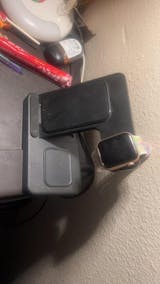Certifications
The majority of ComiLED’s products are supported by different certifications, guaranteeing that our products meet the quality standards you expect. You may be wondering what these certifications are and what they mean. Let's take a deeper look at which certifications can help consumers like you to make confident purchasing decisions.
- UL LISTED -
UL, formerly known as Underwriters Laboratories, is a global independent safety science company in operation since 1894. Founded that same year by Henry Merrill Jr. as the Underwriters' Electrical Bureau, the company was an electrical testing company that tests equipment against a set of safety and functional standards.
Today, UL is a leading test facility in the United States and tests Canadian-made electrical equipment. The goal of the organization is to make sure that electrical equipment is safe to use. Equipment marked with a UL-listed certified enclosure has met high testing standards.
When a product carries a UL-listed label, it indicates that the product tested has met the relevant standards outlined in the Underwriters Laboratories Safety Standards.
- ETL Certification -
Electrical Testing Laboratories (ETL) was founded by Thomas Edison in 1896 as the Lamp Testing Bureau, to ensure the safety of light bulbs. Today, ETL is tested against safety standards and refers to standards published by organizations such as UL, the American Society of Mechanical Engineers (ASME), and the American Society for Testing and Materials (ASTM).
Intertek ETL provides certification marks as evidence of product compliance in the United States, Canada, and other regions around the world.
- FCC -
The Federal Communications Commission (FCC) oversees and enforces regulations and other telecommunications standards regarding products that emit radio frequency energy or other electromagnetic interference that may pose a risk to the public or interfere with radio broadcasts. This enforcement is under Title 47 of the Code of Federal Regulations (CFR) Section 2.907. Certification for radio frequency (RF) equipment is one of the most stringent processes administered by the FCC, owing to the potential for interference with radio services. Test data submitted to the FCC is derived from testing conducted by FCC-accredited and accredited laboratories.
ComiLED LED recessed light and devices equipped with remote, Bluetooth, or WiFi capabilities are FCC-certified because they qualify as radio frequency (RF) devices and are subject to FCC regulations.
- DLE -
The DLC is a consortium of utilities and regional efficiency agencies that is a leader in certifying high-efficiency lighting quality and performance. Its goal is to promote the widespread adoption of high-quality, high-efficiency lighting designs across all commercial lighting sectors. Utilities use DLC-certified product catalogs to promote high-performance solid-state lighting fixtures in areas not covered by U.S. Energy Star standards.
The DLC-certified product catalog is a practical benchmark for evaluating high-quality, high-efficiency lighting products.
- ENERGY STAR -
ENERGY STAR is a government-backed program in the United States focused on energy efficiency. It aims to provide businesses and consumers with reliable and unbiased information to help them make informed decisions.
The ENERGY STAR logo in blue with a white star can be found on ComiLED products.
The Environmental Protection Agency (EPA) ensures that products bearing this logo are independently certified to meet the quality, performance, and energy efficiency standards that consumers expect.
- CE -
The letters “CE” stand for the French phrase “Conformité Européene,” which translates to European Conformity. The CE Mark indicates that a product is legally placed on the market within the European Free Trade Association (EFTA) and the European Union (EU). It confirms that a product meets basic requirements and/or performance levels, as well as complies with Harmonized Standards set by various European standards bodies such as CEN and CENELEC. These standards define the technical specifications that products must meet.
- UKCA –
The UKCA certification is a safety and conformity mark for products on the UK market. It replaced the previous CE certification after the UK exited the European Union. This certification requires products to comply with safety and technical standards and applies to a variety of products sold or used in the UK. It covers a wide range of products. The UKCA certification mark indicates that a product complies with the requirements of British law, which is significant for manufacturers, suppliers, and consumers. By obtaining UKCA certification, products can be legally sold in the UK market and demonstrate their commitment to meeting British safety standards, enhancing competitiveness and market reputation.
- RoHS –
RoHS is a mandatory standard established by EU legislation. Its full name is the Restriction of Hazardous Substances Directive, which aims to restrict the use of certain hazardous substances in electrical and electronic equipment. The standard was officially implemented on July 1, 2006, It mainly regulates the material and process standards of electronic and electrical products to make them more beneficial to human health and environmental protection.
Here are the maximum concentration limits for the six hazardous substances regulated by RoHS:
Cadmium: Less than 100ppm
Lead: Less than 1000ppm
Hexavalent chromium: Less than 1000ppm
Mercury: Less than 1000ppm
Polybrominated biphenyls (PBB): Less than 1000ppm
Polybrominated diphenyl ethers (PBDE): Less than 1000ppm
- SAA –
SAA certification, full name Standards Australia Approvals, is a product certification mark used in Australia to ensure compliance with Australian safety standards and regulatory requirements. This certification is usually issued by the Electrical Regulatory Authorities Council (ERAC) in Australia. Products certified by SAA can be legally sold and used in the Australian market, which is significant for manufacturers, suppliers, and consumers. The SAA certification mark demonstrates a commitment to meeting Australian national standards and helps enhance the market competitiveness and credibility of the products.
We also provide a technical specification on each product page or you can review the specification for each product range through the Manuals and Downloads page.




